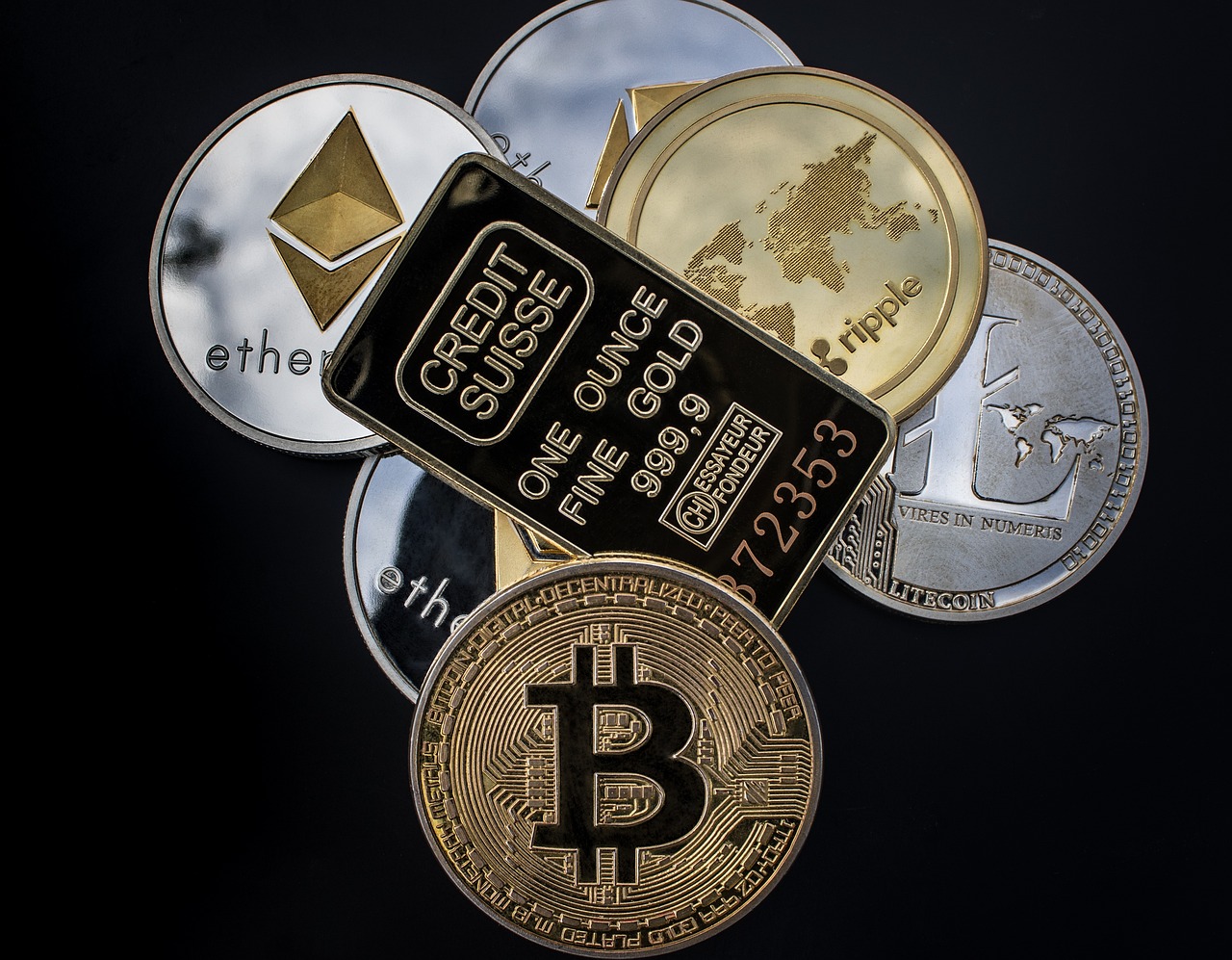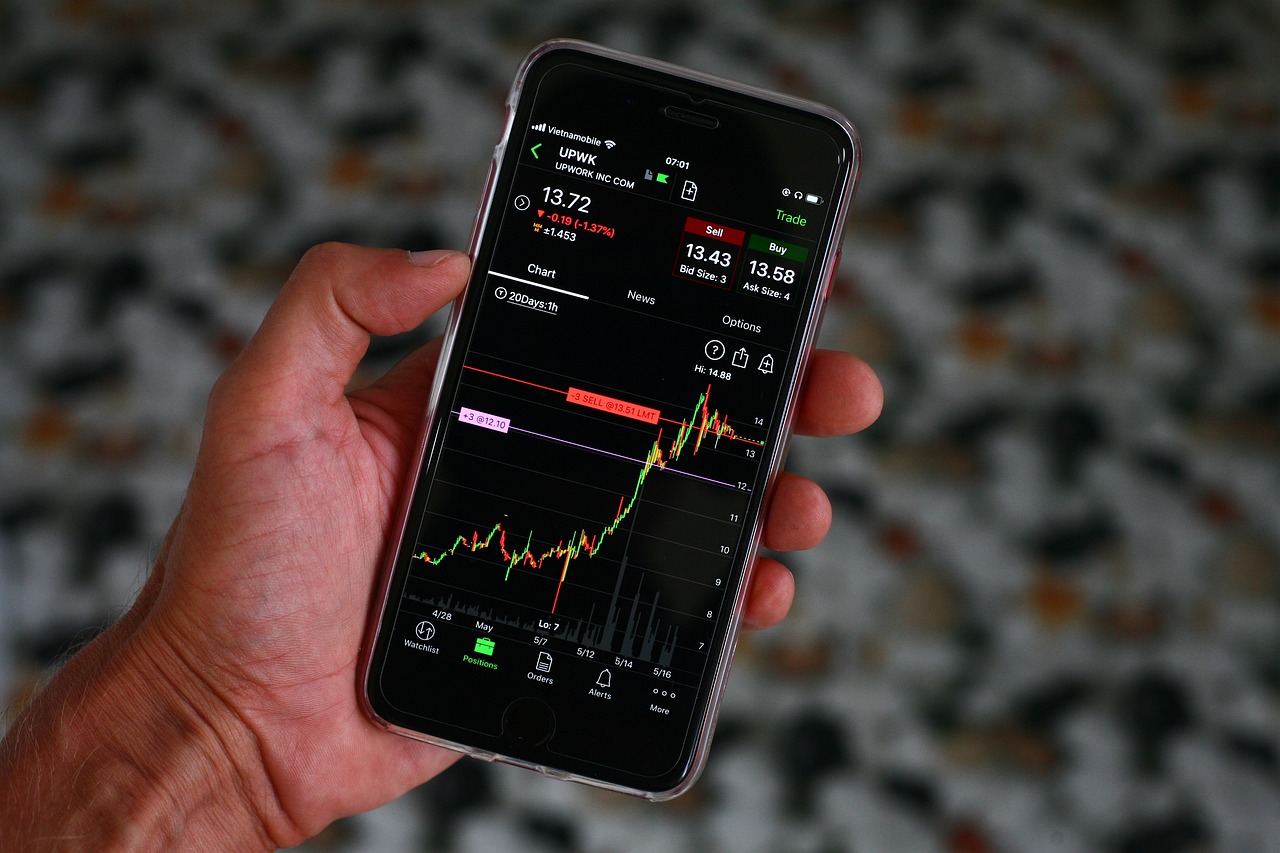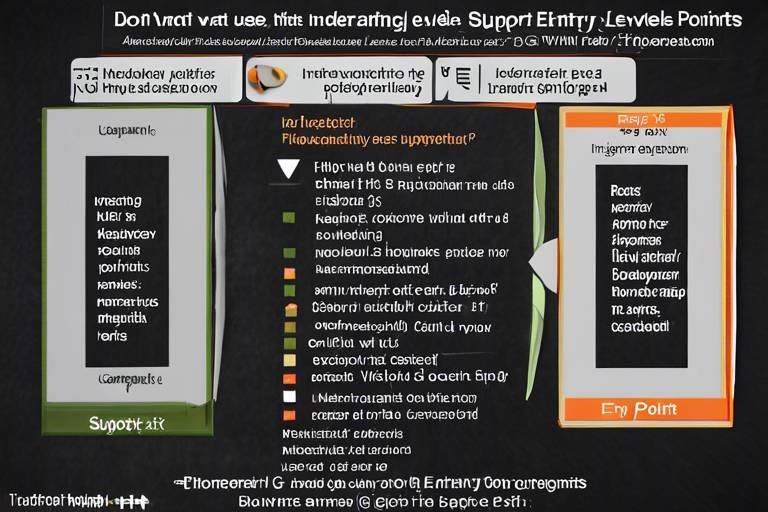Tips for Trading Cryptocurrency on a Budget
Trading cryptocurrency can feel like navigating a wild roller coaster, especially when you're trying to do it on a budget. But fear not! This article aims to arm you with practical strategies that can help you optimize your investments without draining your wallet. In the world of crypto, where the highs can be exhilarating and the lows can be gut-wrenching, smart planning is your best friend. So, are you ready to dive in and learn how to trade wisely while keeping an eye on your budget? Let's get started!
Before you take the plunge into trading, it’s crucial to understand the fundamental concepts of cryptocurrency. Think of it as learning the rules of a game before you start playing. You need to grasp what blockchain technology is, the different types of coins available, and the dynamics of the market. This knowledge is your foundation, and it empowers you to make informed trading decisions. Without it, you might as well be sailing a ship without a compass! So, take some time to familiarize yourself with the basics, and you'll set yourself up for success.
Once you have a solid understanding of the basics, the next step is selecting a reliable cryptocurrency exchange. This choice is like picking the right platform for a video game; it can make or break your experience. Factors such as fees, security, and user experience play a significant role in your trading success. Therefore, it's essential to research your options thoroughly.
Different exchanges have varying fee structures and features, which can significantly impact your bottom line. Understanding these differences is crucial for choosing an exchange that aligns with your trading style and budget. Here’s a quick look at some common fees:
| Type of Fee | Description |
|---|---|
| Trading Fees | Fees charged on each trade you make. |
| Withdrawal Fees | Fees charged when you withdraw your funds. |
| Deposit Fees | Fees for depositing funds into your account. |
By familiarizing yourself with these costs, you can avoid unexpected expenses and plan your budget effectively.
Security should always be a top priority when selecting an exchange. Just like you wouldn’t leave your front door wide open, you need to ensure that your funds are safe. Look for platforms that offer robust security features, such as two-factor authentication and cold storage. These measures can provide peace of mind while you trade on a budget.
A user-friendly interface and responsive customer support can make trading easier, especially for beginners. Selecting an exchange that prioritizes user experience can enhance your trading journey without incurring additional costs. After all, you want to focus on making smart trades, not figuring out how to navigate a complicated platform!
Establishing a clear budget is essential for responsible trading. Think of it as setting a spending limit before a shopping spree—it's easy to get carried away! Determine how much you can afford to invest and stick to this amount. This discipline will help you avoid emotional trading and potential financial loss.
Consider diversifying your investments across different cryptocurrencies to spread risk. Just like you wouldn’t put all your eggs in one basket, allocating funds wisely can help you maximize potential returns while minimizing the impact of market fluctuations on your overall budget. This way, if one investment doesn’t perform as expected, you won’t be left high and dry!
Implementing risk management strategies, such as setting stop-loss orders and limiting your investment per trade, can protect your budget from significant losses while trading in the volatile cryptocurrency market. These tactics act like safety nets, catching you before you fall too far.
Many free resources and tools are available to help you trade cryptocurrency effectively on a budget. Utilizing these can enhance your trading knowledge and skills without incurring additional costs. Why not take advantage of what’s out there?
Online courses, webinars, and articles provide valuable insights into cryptocurrency trading. Engaging with these educational platforms can help you build a solid foundation and improve your trading strategies without spending a dime. Knowledge is power, after all!
There are various free trading tools and software available that can assist you in analyzing market trends, tracking your portfolio, and executing trades efficiently. These tools enable you to trade smartly on a budget, giving you the edge you need to succeed.
- Can I start trading cryptocurrency with a small budget?
Absolutely! Many exchanges allow you to start with minimal investments. - What is the best way to learn about cryptocurrency?
Utilizing free online courses and resources is a great way to start. - How can I ensure my investments are secure?
Choose exchanges with strong security measures like two-factor authentication.

Understanding Cryptocurrency Basics
Before you embark on your exhilarating journey into the world of cryptocurrency trading, it's crucial to grasp the fundamental concepts that underpin this digital phenomenon. Think of cryptocurrency as the new-age currency that operates on a technology called blockchain. This decentralized ledger technology ensures transparency and security, making it nearly impossible to alter transaction records without consensus from the network. Imagine a giant digital notebook shared by millions, where every entry is verified by a group of friends before being written down; that’s the essence of blockchain!
Now, let’s dive into some of the key elements that make up the cryptocurrency ecosystem:
- Various Coins: Bitcoin, Ethereum, Ripple, and Litecoin are just a few of the many cryptocurrencies available today. Each coin has its unique functionalities and use cases. For instance, Bitcoin is often referred to as digital gold, while Ethereum enables smart contracts, opening up a world of decentralized applications.
- Market Dynamics: The cryptocurrency market is notoriously volatile. Prices can skyrocket or plummet within hours based on various factors, including market sentiment, regulatory news, and technological advancements. Being aware of these dynamics will help you navigate the market more wisely.
Understanding these basics is akin to learning the rules of a game before you start playing. If you don’t know the rules, you might find yourself making costly mistakes. So, take the time to familiarize yourself with the different types of cryptocurrencies and how they operate within the broader financial landscape.
Moreover, it’s essential to keep an eye on market trends. Just like weather patterns can influence your weekend plans, market trends can significantly affect your trading strategies. Utilize tools like market analysis websites and cryptocurrency news platforms to stay updated. Remember, knowledge is power, especially in the fast-paced world of crypto.
In summary, understanding the basics of cryptocurrency is your first step towards becoming a savvy trader. With a solid foundation, you’ll be better equipped to make informed decisions, optimize your investments, and minimize risks as you navigate this exciting yet unpredictable market.

Choosing the Right Exchange
When it comes to trading cryptocurrency on a budget, choosing the right exchange is akin to picking the right vehicle for a long journey. You want something reliable, cost-effective, and equipped with all the features you need to navigate the twists and turns of the crypto market. So, how do you go about making this crucial decision? Let’s break it down.
First and foremost, you need to consider fees. Different exchanges have different fee structures, and these can eat into your profits faster than you can say "blockchain." Some exchanges charge a flat fee per trade, while others might take a percentage of your transaction. It's essential to understand these fees because they can significantly impact your overall trading budget. For instance, if you plan to make frequent trades, a platform with lower fees might save you a substantial amount in the long run. Here’s a quick comparison of common fee types:
| Type of Fee | Description |
|---|---|
| Trading Fees | Fees charged for executing trades, usually a percentage of the trade amount. |
| Withdrawal Fees | Fees incurred when transferring funds out of the exchange. |
| Deposit Fees | Charges for depositing funds into your exchange account. |
Next, let’s talk about security. In the world of cryptocurrency, security should be at the top of your priority list. You wouldn’t leave your front door wide open, would you? Similarly, you need to ensure the exchange you choose has robust security measures in place. Look for features like two-factor authentication and cold storage for funds. This can give you peace of mind knowing that your investments are safe from potential hacks and theft.
Another critical aspect to consider is user experience. A platform that is easy to navigate can make your trading journey a lot smoother, especially if you’re just starting out. Imagine trying to drive a car with a confusing dashboard; it would be frustrating, right? The same goes for trading platforms. You want a user-friendly interface that allows you to execute trades quickly and efficiently. Additionally, responsive customer support is invaluable. If you encounter issues or have questions, you want to be able to reach out and get help promptly.
In conclusion, choosing the right exchange is a pivotal step in your cryptocurrency trading journey. By carefully evaluating the fees, security measures, and user experience, you can select a platform that aligns with your trading goals and budget. Remember, this choice can either enhance your trading experience or lead to unnecessary headaches, so take your time and do thorough research!
- What should I look for in a cryptocurrency exchange? Look for low fees, strong security features, and a user-friendly interface.
- Are all exchanges safe to use? No, it's crucial to research and choose exchanges with robust security measures.
- How can I minimize trading fees? Consider exchanges with lower fee structures and avoid frequent trades if possible.

Comparing Fees and Features
When it comes to trading cryptocurrency on a budget, understanding the fees and features of different exchanges is crucial. Not all exchanges are created equal; some may have lower fees but lack essential features, while others might charge higher fees but offer superior tools and security. It’s like shopping for a car: you want to find the best deal that meets your needs without compromising on quality.
First, let’s talk about trading fees. Most exchanges charge a percentage of each trade you make. This can range from as low as 0.1% to as high as 1% or more, depending on the platform. For someone trading on a budget, even a small percentage can add up quickly. For example, if you trade $1,000 worth of cryptocurrency at a 1% fee, you’re looking at a $10 cost just to execute that trade. Over time, these fees can eat into your profits.
Next, consider withdrawal fees. Some exchanges charge a fee every time you take your funds out, which can be a significant cost if you plan to move your investments frequently. Make sure to check the withdrawal fees before you choose an exchange. For example, if one exchange charges $5 for withdrawals while another charges $0.50, you might want to factor that into your decision, especially if you anticipate making frequent withdrawals.
Additionally, keep an eye on deposit fees. While many exchanges offer free deposits via bank transfer, some may charge fees for credit card deposits or other methods. Understanding these costs can help you avoid any surprises when you’re ready to fund your account.
Beyond fees, it’s essential to evaluate the features that each exchange offers. Look for platforms that provide a user-friendly interface, advanced trading tools, and robust security measures. For instance, some exchanges offer features like:
- Charting Tools: Great for analyzing market trends.
- Mobile Apps: Allow you to trade on the go.
- API Access: For those who want to automate their trading strategies.
To make an informed decision, it’s a good idea to create a comparison table of the exchanges you’re considering. Here’s a simple example:
| Exchange Name | Trading Fee | Withdrawal Fee | Deposit Fee | Features |
|---|---|---|---|---|
| Exchange A | 0.1% | $5 | Free (Bank Transfer) | Advanced Charting, Mobile App |
| Exchange B | 0.2% | $0.50 | Free (Credit Card) | API Access, User-Friendly Interface |
By comparing these aspects, you can choose an exchange that not only fits your budget but also provides the features that will enhance your trading experience. Remember, the goal is to find a balance between cost and capability, ensuring that you can trade effectively without overspending.

Types of Fees
When trading cryptocurrency, understanding the associated with exchanges is crucial for managing your budget effectively. Every exchange has its own fee structure, which can vary significantly. This means that what might seem like a good deal at first glance could end up costing you more in the long run. Let's break down the most common types of fees you should be aware of:
- Trading Fees: These are the fees charged for executing trades. They can be a flat rate or a percentage of the transaction value. Some exchanges offer a tiered structure, where the percentage decreases based on your trading volume over a specific period.
- Withdrawal Fees: When you want to move your cryptocurrency from the exchange to your wallet, a withdrawal fee is typically applied. This fee can vary depending on the cryptocurrency you are withdrawing.
- Deposit Fees: While many exchanges have eliminated deposit fees for certain currencies, some may still charge you when funding your account. It’s essential to check if your chosen exchange has any deposit fees associated with credit card transactions or bank transfers.
Understanding these fees is vital because they can eat into your profits. For example, if you are trading a cryptocurrency that has a high trading fee, you might find your gains diminished significantly. To illustrate, consider the following hypothetical fee structure for three different exchanges:
| Exchange | Trading Fee (%) | Withdrawal Fee (BTC) | Deposit Fee (%) |
|---|---|---|---|
| Exchange A | 0.25% | 0.0005 BTC | 0% |
| Exchange B | 0.15% | 0.0003 BTC | 1% |
| Exchange C | 0.20% | 0.0004 BTC | 0% |
As you can see, Exchange B offers the lowest trading fee and withdrawal fee, but it charges a deposit fee, which could impact your initial investment. Therefore, it’s essential to do your homework and calculate how these fees will affect your trading strategy. The goal is to choose an exchange that minimizes these costs while still providing the features and security you need.
In conclusion, being aware of the types of fees can significantly enhance your trading experience. By carefully analyzing the fee structures of various exchanges, you can make informed decisions that align with your budget and trading goals. Remember, every penny counts in the world of cryptocurrency!
1. What is the average trading fee for cryptocurrency exchanges?
Most exchanges charge between 0.1% to 0.5% per trade. However, fees can vary based on your trading volume and the specific exchange.
2. Are there exchanges with no trading fees?
Yes, some exchanges offer zero trading fees, but they may charge higher withdrawal fees or have other costs associated with their services.
3. How can I avoid high fees while trading?
To avoid high fees, consider using exchanges with lower fee structures, trading in higher volumes to benefit from tiered pricing, and always check for hidden fees.
4. Do fees differ for different cryptocurrencies?
Yes, withdrawal fees can vary significantly between different cryptocurrencies, so it’s essential to check the fees associated with each coin you plan to trade.

Security Measures
When it comes to trading cryptocurrency on a budget, security should be at the forefront of your mind. The digital nature of cryptocurrencies makes them particularly vulnerable to various threats, including hacks and scams. Therefore, choosing an exchange with robust security features is not just a recommendation; it's a necessity. One of the first things to look for is two-factor authentication (2FA). This additional layer of security requires you to provide two forms of identification before accessing your account, making it significantly harder for unauthorized users to gain access.
Another critical aspect to consider is whether the exchange uses cold storage for funds. Cold storage means that the majority of the cryptocurrency held by the exchange is kept offline, away from the reach of hackers. Only a small percentage is kept in hot wallets for immediate trading needs. This method drastically reduces the risk of theft. Additionally, look for exchanges that offer insurance policies for funds stored on their platform. This can provide peace of mind, knowing that your assets are protected even in the event of a breach.
It's also essential to stay informed about the security practices of the exchange you choose. Regularly check their security audits and any past incidents involving breaches. Transparency is a good indicator of how seriously an exchange takes its security measures. Moreover, be wary of exchanges that don’t provide clear information about their security protocols; this could be a red flag.
Lastly, take personal responsibility for your own security. Use strong, unique passwords for your accounts and consider using a password manager to keep track of them. Regularly updating your passwords and enabling security features like withdrawal whitelists—which restrict withdrawals to specific wallet addresses—can further protect your funds. Remember, while exchanges can provide a secure platform, the ultimate responsibility for your security lies with you.
- What is two-factor authentication (2FA)?
2FA is a security process that requires two different forms of identification before granting access to an account, enhancing security significantly.
- Why is cold storage important?
Cold storage keeps the majority of funds offline, making them less vulnerable to hacks and cyberattacks.
- How can I ensure my exchange is secure?
Research the exchange's security features, read user reviews, and check for any past security breaches.

User Experience and Support
When it comes to trading cryptocurrency, the user experience on the exchange platform can make or break your trading journey. Imagine trying to navigate a complex maze with no map; that’s what trading can feel like on a poorly designed platform. A user-friendly interface is essential for both beginners and seasoned traders alike. You want to be able to execute trades quickly and efficiently without feeling overwhelmed by unnecessary clutter or confusing layouts. A clean and intuitive design allows you to focus on what really matters: making informed trading decisions.
Additionally, customer support plays a pivotal role in your trading experience. In the fast-paced world of cryptocurrency, issues can arise unexpectedly. Whether it’s a technical glitch, a question about a transaction, or a need for assistance with account security, having access to responsive customer support can alleviate a lot of stress. Look for exchanges that offer multiple channels for support, such as live chat, email, and phone support. The quicker you can get answers to your questions, the less likely you are to make impulsive decisions that could impact your budget.
To provide a clearer picture, here’s a quick comparison of the support features you should consider when choosing a cryptocurrency exchange:
| Exchange | Live Chat | Email Support | Phone Support | Response Time |
|---|---|---|---|---|
| Exchange A | Yes | Yes | No | Within 1 hour |
| Exchange B | No | Yes | Yes | Within 24 hours |
| Exchange C | Yes | No | No | Within 30 minutes |
As you can see, different exchanges offer varying levels of support. It’s crucial to select a platform that aligns with your needs, especially if you’re trading on a budget. You don’t want to be stuck waiting for a response during a crucial trading moment. Remember, a good exchange will not only have a great interface but also a support team ready to assist you when you need it most.
In summary, prioritizing user experience and support when selecting a cryptocurrency exchange can enhance your trading journey significantly. A seamless interface combined with robust customer support can empower you to trade confidently, allowing you to focus on your strategies rather than technical difficulties or unanswered questions.
- What should I look for in a cryptocurrency exchange? Look for user-friendly interfaces, low fees, robust security, and responsive customer support.
- How can I ensure my funds are safe while trading? Choose exchanges with strong security measures, such as two-factor authentication and cold storage.
- Is it necessary to have a budget for trading? Yes, establishing a budget helps you avoid emotional trading and manage risks effectively.
- What resources can help me learn more about cryptocurrency trading? Online courses, webinars, and articles are great free resources to enhance your knowledge.

Setting a Realistic Budget
Establishing a clear budget is essential for responsible trading in the cryptocurrency market. Think of your budget as a financial safety net; it’s there to catch you if the market takes a tumble. Before you even think about diving into trading, take a moment to assess your financial situation. Ask yourself, "How much can I afford to invest without jeopardizing my daily expenses or savings?" This question is crucial because emotional trading often leads to poor decisions, and you want to avoid that pitfall.
Once you've determined a comfortable amount, it's vital to stick to this budget. The thrill of trading can sometimes blur the lines of rational decision-making. You might feel tempted to invest more when you see a potential opportunity or when a trade goes well, but remember: sticking to your budget is key. If you stray from your set amount, you risk falling into the trap of emotional trading, which can lead to significant financial losses. To help you stay on track, consider setting reminders or using budgeting apps that alert you when you're nearing your limit.
Moreover, it’s wise to allocate your budget wisely. Diversification is not just a buzzword; it’s a strategy that can minimize risk. Instead of putting all your eggs in one basket, think about spreading your investments across multiple cryptocurrencies. For instance, you might allocate 50% of your budget to a well-established coin like Bitcoin, 30% to a promising altcoin, and the remaining 20% to a high-risk, high-reward token. This way, if one investment doesn’t pan out, the others might cushion the blow.
| Investment Allocation | Percentage |
|---|---|
| Bitcoin | 50% |
| Altcoin | 30% |
| High-risk Token | 20% |
Establishing risk management strategies is another crucial component of your budgeting plan. This could include setting stop-loss orders to limit potential losses or deciding on a maximum amount to invest in a single trade. By implementing these strategies, you can protect your budget from unforeseen market fluctuations. For instance, if you set a stop-loss at 10%, your investment will automatically sell if it drops to that level, preventing further losses. Think of it as putting up a safety barrier around your finances.
Finally, always remember that trading is a marathon, not a sprint. It’s easy to get caught up in the excitement of quick gains, but a realistic budget helps you maintain a steady pace. By trading within your means and applying sound budgeting principles, you’ll not only enhance your trading experience but also build a more sustainable investment strategy over time.
- How much should I budget for cryptocurrency trading? Your budget should be an amount you can afford to lose without affecting your essential finances.
- What is the best way to diversify my investments? Consider allocating your budget across different cryptocurrencies and sectors to spread risk.
- How can I manage my risks while trading? Implement strategies like stop-loss orders and limit your investment per trade to mitigate potential losses.

Allocating Funds Wisely
When it comes to trading cryptocurrency on a budget, allocating your funds wisely is one of the most crucial steps you can take. Think of your investment like a garden; if you want a bountiful harvest, you need to plant your seeds in the right spots. This means diversifying your investments across different cryptocurrencies rather than putting all your eggs in one basket. By spreading your funds across various coins, you can minimize the risk associated with the volatile nature of the crypto market.
Consider the following key points when allocating your funds:
- Diversification: Just like a well-balanced diet, your cryptocurrency portfolio should include a mix of different assets. This could involve investing in established coins like Bitcoin and Ethereum while also exploring promising altcoins. This approach not only spreads risk but can also maximize your potential returns.
- Market Research: Before you allocate funds, do your homework! Research the cryptocurrencies you’re interested in. Look into their market trends, technological advancements, and community support. This knowledge can guide you in making informed decisions about where to invest.
- Risk Tolerance: Everyone has a different appetite for risk. Are you a cautious investor or a thrill-seeker? Understanding your risk tolerance is essential in determining how much to allocate to each asset. If you prefer a safer approach, consider allocating a larger portion to stablecoins, while allowing a smaller percentage for more volatile options.
To further illustrate the importance of wise fund allocation, let's take a look at a hypothetical example:
| Cryptocurrency | Investment Amount | Percentage of Total Budget |
|---|---|---|
| Bitcoin (BTC) | $500 | 50% |
| Ethereum (ETH) | $300 | 30% |
| Ripple (XRP) | $100 | 10% |
| Cardano (ADA) | $100 | 10% |
In this example, the investor has allocated their $1,000 budget in a way that balances safety and potential growth. By investing 50% in Bitcoin, which is generally considered a more stable asset, while also experimenting with smaller amounts in altcoins, they can take advantage of market opportunities without overexposing themselves to risk.
Ultimately, the key to allocating funds wisely lies in understanding your own financial situation, goals, and the market landscape. Remember, it’s not just about how much you invest, but how strategically you allocate those funds that can lead to success in the crypto trading game.

Establishing Risk Management Strategies
When it comes to trading cryptocurrency, one of the most critical aspects that often gets overlooked is risk management. You see, the crypto market is notoriously volatile, and without a solid plan in place, you could easily find yourself in a financial pickle. So, how do you safeguard your investments while still aiming for potential profits? Let's dive into some practical strategies that can help you navigate these turbulent waters.
First off, one of the most effective ways to manage risk is by setting stop-loss orders. Think of these as your safety net. A stop-loss order automatically sells your cryptocurrency when it drops to a certain price, preventing further losses. For instance, if you buy Bitcoin at $40,000 and set a stop-loss at $38,000, your investment will automatically sell if the price plummets to that level. This strategy allows you to maintain control over your investments and avoid emotional decision-making during market downturns.
Another vital component of risk management is to limit your investment per trade. A common rule of thumb is to never invest more than 1-2% of your total trading capital in a single trade. This way, even if a trade goes south, your overall portfolio remains intact. For example, if you have $10,000 in your trading account, you should consider investing no more than $100 to $200 in any single trade. This practice not only reduces your risk exposure but also allows you to diversify your trades, which is another essential strategy.
Speaking of diversification, it’s crucial to spread your investments across different cryptocurrencies. Instead of putting all your eggs in one basket, consider allocating your budget to various coins. This approach can significantly reduce the impact of a poor-performing asset on your overall portfolio. For instance, if you invest in five different cryptocurrencies, and one of them takes a hit, the others may still perform well, balancing out your losses. Remember, the goal here is to mitigate risk while still capitalizing on the potential for significant returns.
Moreover, keeping a trading journal can be an invaluable tool for managing risk. By documenting your trades, strategies, and the outcomes, you can identify patterns in your decision-making process. This practice not only helps you understand what works and what doesn’t but also encourages you to be more disciplined in your trading approach. Over time, you’ll be able to refine your strategies and make more informed decisions.
Lastly, always stay updated with market trends and news. The cryptocurrency landscape changes rapidly, and being informed can give you a significant advantage. Utilize various resources—like news websites, forums, and social media—to keep your finger on the pulse of the market. This knowledge can help you make timely decisions and adjust your risk management strategies accordingly.
In summary, establishing effective risk management strategies is crucial for any cryptocurrency trader, especially those working with a limited budget. By implementing stop-loss orders, limiting your investment per trade, diversifying your portfolio, keeping a trading journal, and staying informed, you can protect your capital and navigate the volatile market with greater confidence.
- What is a stop-loss order? A stop-loss order is a type of order that automatically sells your cryptocurrency when it reaches a predetermined price, helping to minimize losses.
- How much of my capital should I invest in a single trade? It's generally advisable to invest no more than 1-2% of your total trading capital in a single trade to reduce risk exposure.
- Why is diversification important in cryptocurrency trading? Diversification helps spread risk across different assets, reducing the impact of a poor-performing investment on your overall portfolio.
- What should I include in my trading journal? Your trading journal should include details about each trade, such as entry and exit points, the rationale behind your decisions, and the outcomes.
- How can I stay updated with market trends? Utilize news websites, social media, and cryptocurrency forums to stay informed about market trends and developments.

Utilizing Free Resources and Tools
In the ever-evolving world of cryptocurrency, staying informed is key to successful trading, especially when you're on a budget. Thankfully, there are a plethora of free resources and tools at your disposal that can help you navigate the complexities of the crypto market without spending a dime. Imagine having a treasure map that leads you to hidden gems of knowledge; that's exactly what these resources can do for you!
First off, online courses and webinars are fantastic avenues to deepen your understanding of cryptocurrency trading. Platforms like Coursera and Udemy often offer free courses that cover everything from the basics of blockchain technology to advanced trading strategies. Engaging with these educational resources can equip you with the skills you need to make informed decisions. Think of it as a gym for your brain—working out your knowledge muscles!
In addition to courses, you can find a wealth of articles and blogs dedicated to cryptocurrency trading. Websites like CoinDesk and Investing.com provide up-to-date news, analysis, and insights that can help you stay ahead of market trends. By regularly reading these resources, you can develop a keen sense of market dynamics, which is crucial for making sound trading decisions.
Another essential category of free tools includes trading software and applications. Many platforms offer free versions that allow you to analyze market trends, track your portfolio, and even execute trades. For example, tools like TradingView provide advanced charting features and community-driven insights that can enhance your trading strategy. It's like having a personal trading assistant right at your fingertips!
Moreover, social media can be an invaluable resource for real-time updates and community support. Platforms like Twitter and Reddit host vibrant communities where traders share tips, strategies, and market news. Following influential traders and engaging in discussions can provide you with fresh perspectives and ideas. Just remember, though, that not all advice is created equal—always do your own research!
To summarize, utilizing free resources and tools is not just a smart way to save money; it's a vital strategy for anyone looking to succeed in cryptocurrency trading. By taking advantage of online courses, articles, trading tools, and social media, you can significantly enhance your trading knowledge and skills without stretching your budget. So, roll up your sleeves and dive into this treasure trove of information—your future self will thank you!
Q: Are there really free resources that can help me trade cryptocurrency?
A: Absolutely! There are many free online courses, articles, and trading tools available to help you understand and navigate the crypto market.
Q: How do I know which trading tools are the best?
A: Look for user reviews, community recommendations, and features that align with your trading style. Many platforms offer free trials, so you can test them out before committing.
Q: Can social media really help me with trading?
A: Yes! Social media platforms like Twitter and Reddit have active communities where traders share insights and strategies. However, always verify the information you receive.

Educational Platforms
When it comes to trading cryptocurrency on a budget, leveraging can be a game-changer. These resources offer a plethora of information that can significantly enhance your understanding of the crypto market without costing you a dime. Imagine trying to navigate a maze without a map; that’s what trading without education feels like. By engaging with these platforms, you equip yourself with the knowledge to make informed decisions, thus reducing the risk of costly mistakes.
One of the most accessible ways to learn about cryptocurrency is through online courses. Many platforms offer free or low-cost courses that cover everything from the basics of blockchain technology to advanced trading strategies. Websites like Coursera, Udemy, and Khan Academy provide structured learning paths that help demystify the complexities of crypto trading. Additionally, you can find specialized courses focusing on technical analysis, market psychology, and risk management, which are crucial for successful trading.
Another fantastic resource is webinars. These live sessions often feature expert speakers who share their insights and answer questions from participants. Not only do you get to learn from seasoned professionals, but you also have the opportunity to engage in real-time discussions. This interaction can be invaluable, especially for beginners who may have specific questions or concerns about their trading strategies. Platforms like Binance and Coinbase frequently host webinars that cover various topics related to cryptocurrency trading.
Moreover, don't underestimate the power of articles and blogs. Many financial websites and crypto enthusiasts maintain blogs that provide up-to-date information, market analyses, and trading tips. Reading these articles can keep you informed about the latest trends and developments in the crypto world. Websites like CoinDesk, CryptoSlate, and Medium have extensive sections dedicated to cryptocurrency education, making them excellent resources for traders of all levels.
In addition to these traditional educational platforms, consider joining online communities and forums. Platforms like Reddit and Discord have active cryptocurrency trading communities where members share their experiences, strategies, and insights. Participating in these discussions can provide you with a broader perspective on market trends and trading tactics. Just remember, while community advice can be helpful, it’s essential to do your own research and verify the information you receive.
Finally, many exchanges offer their own educational resources, including tutorials and guides tailored to their platforms. For instance, Binance Academy provides a wealth of information on various topics related to cryptocurrency, from beginner guides to advanced trading techniques. By utilizing these resources, you can familiarize yourself with the specific tools and features of the exchange you choose, making your trading experience smoother and more efficient.
In summary, the world of cryptocurrency is vast and complex, but with the right educational platforms at your disposal, you can navigate it more confidently. By investing your time in learning through courses, webinars, articles, and community engagement, you not only enhance your trading skills but also set yourself up for long-term success in the ever-evolving crypto landscape.
1. What are the best platforms for learning about cryptocurrency?
There are several excellent platforms including Coursera, Udemy, Binance Academy, and various cryptocurrency blogs like CoinDesk. Each offers unique resources tailored to different learning styles.
2. Are webinars worth attending for cryptocurrency education?
Absolutely! Webinars provide live interaction with experts and allow you to ask questions in real-time, making them a valuable resource for deepening your understanding of the market.
3. How can online communities help with cryptocurrency trading?
Online communities allow you to share experiences, learn from others, and gain insights into market trends. However, always verify the information you receive and conduct your own research.
4. Is it necessary to pay for cryptocurrency courses?
While many high-quality free resources are available, paid courses can offer more structured learning and in-depth insights, which can be beneficial for serious traders.

Trading Tools and Software
When it comes to trading cryptocurrency on a budget, leveraging the right can make all the difference. These resources not only enhance your trading experience but also help you make informed decisions without spending a fortune. Imagine having a personal assistant that analyzes market trends, tracks your investments, and executes trades on your behalf. Sounds great, right? Well, that’s what these tools can do for you!
First off, let’s talk about charting tools. These are essential for any trader looking to analyze price movements and trends. Platforms like TradingView offer free versions that provide you with advanced charting capabilities, allowing you to spot potential entry and exit points. You can customize charts with various indicators, making it easier to visualize market conditions. Plus, you can share your insights with a community of traders, which is a fantastic way to learn from others.
Another invaluable resource is portfolio trackers. Keeping tabs on your investments is crucial, especially in the fast-paced world of cryptocurrency. Tools like CoinMarketCap and Blockfolio allow you to monitor your portfolio's performance in real-time. You can see how each coin is performing, track your gains and losses, and even receive price alerts. This way, you’ll never miss an opportunity to act on market movements.
Furthermore, trading bots are becoming increasingly popular among budget-conscious traders. These automated programs can execute trades based on predefined criteria, taking the emotion out of trading. While some bots come with a cost, there are plenty of free options available, like Gekko and Zenbot. They can help you capitalize on market fluctuations without constantly monitoring your screen, allowing you to trade smarter, not harder.
Lastly, don't underestimate the power of educational resources. Websites like CoinDesk and Investopedia offer a wealth of information about cryptocurrency trading. Whether you're a beginner or an experienced trader, these platforms provide articles, tutorials, and even forums where you can ask questions and get advice from seasoned traders. The best part? Most of this content is available for free, making it an excellent way to enhance your knowledge without impacting your budget.
In conclusion, utilizing the right trading tools and software can significantly improve your trading experience while keeping costs low. From charting tools that help visualize market trends to portfolio trackers that keep your investments organized, these resources are invaluable for anyone looking to trade cryptocurrency on a budget. So, why not take advantage of these tools and elevate your trading game today?
Q: Do I need to pay for trading tools?
A: While some advanced trading tools and software require a subscription, many excellent free options are available that can meet your trading needs.
Q: How can I choose the right trading tool for me?
A: Consider your trading style and needs. If you focus on technical analysis, charting tools are essential. For portfolio management, look for portfolio trackers. Read reviews and try out different tools to find what works best for you.
Q: Are trading bots safe to use?
A: Most trading bots are safe, but it's crucial to do your research. Choose reputable bots with positive reviews and understand how they operate before using them to trade.
Frequently Asked Questions
- What is cryptocurrency trading?
Cryptocurrency trading involves buying and selling digital currencies like Bitcoin, Ethereum, and others on various exchanges. Traders aim to profit from price fluctuations, much like stock trading, but with the added excitement and volatility of the crypto market.
- How much money do I need to start trading cryptocurrency?
You can start trading cryptocurrency with a modest budget. Many exchanges allow you to buy fractions of coins, so even a small investment can get you started. Just ensure you set a realistic budget that you can afford to lose, as the market can be unpredictable.
- What factors should I consider when choosing a cryptocurrency exchange?
When choosing an exchange, consider factors such as fees, security features, user experience, and customer support. Make sure the platform has a good reputation and offers the features that suit your trading style.
- What are the different types of fees associated with cryptocurrency trading?
Exchanges typically charge several types of fees, including trading fees (a percentage of each trade), withdrawal fees (for moving funds off the exchange), and deposit fees (for putting money into your account). Understanding these can help you manage your budget effectively.
- How can I minimize risks while trading cryptocurrency?
To minimize risks, establish a solid budget, use stop-loss orders to limit potential losses, and diversify your investments across different cryptocurrencies. This way, if one asset performs poorly, your overall portfolio won't take a massive hit.
- Are there free resources available for learning about cryptocurrency trading?
Absolutely! There are numerous free resources such as online courses, webinars, articles, and even trading tools that can help you learn about cryptocurrency trading without spending a dime. Take advantage of these to build your knowledge and skills.
- What are stop-loss orders, and why are they important?
A stop-loss order is a predetermined price at which you sell a cryptocurrency to prevent further losses. They are crucial in protecting your budget from significant downturns in the market and can help you trade more confidently.
- Can I trade cryptocurrency on my mobile device?
Yes! Most reputable exchanges offer mobile apps that allow you to trade on the go. This flexibility means you can keep an eye on your investments and execute trades whenever and wherever you are.



















